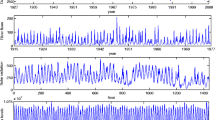Abstract
The detection and transmission of a physical variable over time, by a node of a sensor network to its sink node, represents a significant communication overload and consequently one of the main energy consumption processes. In this article we present an algorithm for the prediction of time series, with which it is expected to reduce the energy consumption of a sensor network, by reducing the number of transmissions when reporting to the sink node only when the prediction of the sensed value differs in certain magnitude, to the actual sensed value. For this end, the proposed algorithm combines a wavelet multiresolution transform with robust prediction using Gaussian process. The data is processed in wavelet domain, taking advantage of the transform ability to capture geometric information and decomposition in more simple signals or subbands. Subsequently, the decomposed signal is approximated by Gaussian process one for each subband of the wavelet, in this manner the Gaussian process is given to learn a much simple signal. Once the process is trained, it is ready to make predictions. We compare our method with pure Gaussian process prediction showing that the proposed method reduces the prediction error and is improves large horizons predictions, thus reducing the energy consumption of the sensor network.






Similar content being viewed by others
References
Le Borgne, Y.-A., Santini, S., & Bontempi, G. (2007). Adaptive model selection for time series prediction in wireless sensor networks. Signal Processing, 87(12), 3010–3020.
Lazaridis, I., & Mehrotra, S. (2003). Capturing sensor-generated time series with quality guarantees. In Proceedings 19th international conference on data engineering (Cat. No. 03CH37405). IEEE.
Madden, S., Franklin, M. J., Hellerstein, J. M., & Hong, W. (2002). Tag: a tiny aggregation service for ad-hoc sensor networks. SIGOPS Operating Systems Review, 36(SI), 131–146.
Nath, S., Gibbons, P. B., Seshan, S., & Anderson, Z. R. (2004). Synopsis diffusion for robust aggregation in sensor networks. In SenSys.
Goel, S., & Imielinski, T. (2001). Prediction-based monitoring in sensor networks: Taking lessons from MPEG. SIGCOMM Computer Communication Review, 31(5), 82–98.
Längkvist, M., Karlsson, L., & Loutfi, A. (2014). A review of unsupervised feature learning and deep learning for time-series modeling. Pattern Recognition Letters, 42, 11–24.
Tulone, D., & Madden, S. (2006). PAQ: Time series forecasting for approximate query answering in sensor networks. In European workshop on wireless sensor networks. Berlin: Springer.
Ji, H., et al. (2017). Distributed information-weighted Kalman consensus filter for sensor networks. Automatica, 77, 18–30.
Ma, X., et al. (2015). Long short-term memory neural network for traffic speed prediction using remote microwave sensor data. Transportation Research Part C: Emerging Technologies, 54, 187–197.
Hochreiter, S., & Schmidhuber, J. (1997). Long short-term memory. Neural Computation, 9(8), 1735–1780.
Krizhevsky, A., Sutskever, I., & Hinton, G. E. (2012). Imagenet classification with deep convolutional neural networks. In F. Pereira, C. J. C. Burges, L. Bottou, & K. Q. Weinberger (Eds.), Advances in neural information processing systems (pp. 1097–1105).
Girard, A., Rasmussen, C. E., Candela, J. Q., & Murray-Smith, R. (2003). Gaussian process priors with uncertain inputs application to multiple-step ahead time series forecasting. In Advances in neural information processing systems (pp. 545–552).
Osborne, M. A., et al. (2008). Towards real-time information processing of sensor network data using computationally efficient multi-output Gaussian processes. In 2008 international conference on information processing in sensor networks (IPSN 2008). IEEE.
Richter, P., & Toledano-Ayala, M. (2015). Revisiting Gaussian process regression modeling for localization in wireless sensor networks. Sensors, 15(9), 22587–22615.
Roberts, S., Osborne, M., Ebden, M., Reece, S., Gibson, N., & Aigrain, S. (2013). Gaussian processes for time-series modelling. Philosophical Transactions of the Royal Society A, 371, 20110550.
Rogers, A., Maleki, S., Ghosh, S., and Jennings, N. R. (2011). Adaptive home heating control through Gaussian process prediction and mathematical programming. eprints.soton.ac.uk. Nychka, D.
Leith, D. J., Heidl, M., & Ringwood, J. V. (2004). Gaussian process prior models for electrical load forecasting. In International conference on probabilistic methods applied to power systems (pp. 112–117).
Bandyopadhyay, S., Hammerling, D., Lindgren, F., & Sain, S. (2015). A multiresolution Gaussian process model for the analysis of large spatial datasets. Journal of Computational and Graphical Statistics, 24(2), 579–599.
Percival, D. B., & Walden, A. T. (2006). Wavelet methods for time series analysis (Vol. 4). Cambridge: Cambridge University Press.
Soltani, S. (2002). On the use of the wavelet decomposition for time series prediction. Neurocomputing, 48(1), 267–277.
Strang, G., & Nguyen, T. (1996). Wavelets and filter banks. Cambridge: SIAM.
Rasmussen, C. E., & Williams, C. K. (2006). Gaussian processes for machine learning. Cambridge: MIT Press.
Chang, T., & Kuo, C. C. J. (1993). texture analysis and classification with tree-structured wavelet tranform. IEEE Transactions on Image Processing, 2(4), 429–441.
Mallat, S. (1999). A wavelet tour of signal processing. Cambridge: Academic Press.
Vaidyanathan, P. P. (1993). Multirate systems and filter banks. Upper Saddle River: Prentice Hall.
De Vito, S., Massera, E., Piga, M., Martinotto, L., & Di Francia, G. (2008). On field calibration of an electronic nose for benzene estimation in an urban pollution monitoring scenario. Sensors and Actuators B: Chemical, 129(2), 750–757.
Buitinck, L., Louppe, G., Blondel, M., Pedregosa, F., Mueller, A., Grisel, O., et al. (2013). Design for machine learning software: experiences from the scikit-learn project. In ECML PKDD workshop: Languages for data mining and machine learning (pp. 108–122).
Lucas, D. D., Yver Kwok, C., Cameron-Smith, P., Graven, H., Bergmann, D., Guilderson, T. P., et al. (2015). Designing optimal greenhouse gas observing networks that consider performance and cost. Geoscientific Instrumentation, Methods and Data Systems, 4(1), 121–137.
Acknowledgements
Funding was provided by Sistema Nacional de Investigadores, CONACYT, México.
Author information
Authors and Affiliations
Corresponding author
Additional information
Publisher's Note
Springer Nature remains neutral with regard to jurisdictional claims in published maps and institutional affiliations.
Rights and permissions
About this article
Cite this article
Mejia, J., Ochoa-Zezzatti, A., Cruz-Mejía, O. et al. Prediction of time series using wavelet Gaussian process for wireless sensor networks. Wireless Netw 26, 5751–5758 (2020). https://doi.org/10.1007/s11276-020-02250-1
Published:
Issue Date:
DOI: https://doi.org/10.1007/s11276-020-02250-1




